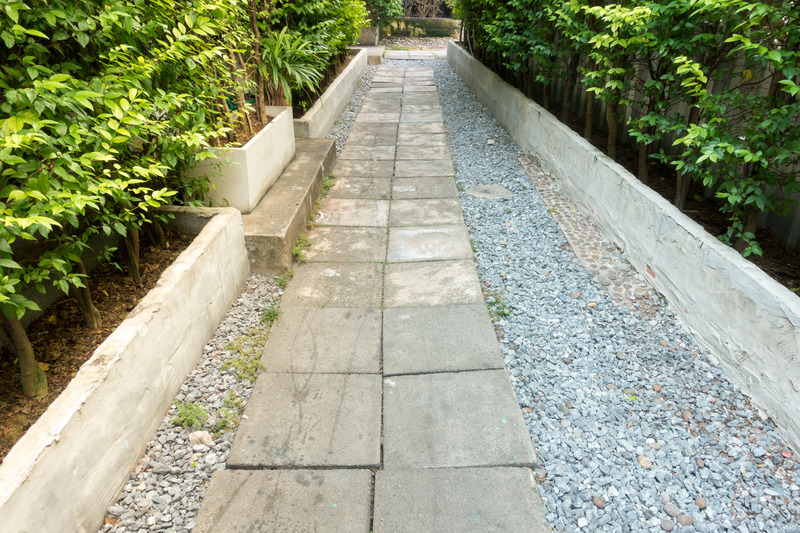This article is an excerpt from the book called “California Home Landscaping” by “Roger Holmes & Lance Walheim”. A short description on clearing the site project for yard or any home improvement projects.
The site you’ve chosen for a landscaping project may or may not need to be cleared of fences, old pavement, construction debris, and other objects. Unless your house is newly built, the site will almost certainly be covered with plants.

Landscaping in the garden.
Before you start cutting plants down, try to find someone to identify them for you. As you walk around together, make a sketch that shows which plants, too. Determine if there are any desirable plants worth saving- mature shade trees that you should work around, shapely shrubs that aren’t too big to dig up and relocate or give away, worthwhile perennials and ground covers that you could divide and replant, healthy sod that you could lay elsewhere. Likewise, decide which plants have to go- diseased or cooked trees, straggly or overgrown shrubs, weedy brush, invasive ground covers, tattered lawn.
You can clear small areas yourself, bundling the brush for pickup and tossing soft-stemmed plants on the compost pile, but if you have lots of woody brush or any trees to remove, you might want to hire someone else to do the job. A crew armed with power tools can turn a thicket into a pile of wood chips in just a few hours. Have them pull out the roots and grind the stumps, too. Save the chips; they’re good for surfacing paths, or you can use them as mulch.
Working around a tree
If there are any large, healthy trees on your site, be careful as you work around them. It’s okay to prune off some of a tree’s limbs but respect its trunk and its roots. Keep heavy equipment from beneath the tree’s canopy, and don’t raise or lower the level of the soil there. Try never to cut or wound the bark on the trunk (don’t nail things to a tree), because that exposes the tree to disease organisms. Plantings beneath existing California natives such as oak trees or madrones can endanger their health. Consult a certified arborist on ways to integrate these handsome, but sensitive, trees into your landscape and care for them properly.
Killing Perennial Weeds
Some common weeds that sprout back from perennial roots or runners are bind-weed, blackberry, Bermuda grass, Johnson grass, nutsedge, and poison oak. Garden plants that can become weedy include bamboo, English ivy, ground ivy, pampas grass, broom, and mint. Once they get established, perennial weeds are hard to eliminate. You can’t just cut off the tops, because the plants keep sprouting back. You need to dig the weeds out, smother them, or kill them with an herbicide, and it’s better to do this before you plant a bed.
Digging
You can often do a good job of removing a perennial weed if you dig carefully at the base of the stems, find the roots, and follow them as far as possible through the soil, pulling out every bit of root that you find. Some plant roots go deeper than you can dig. Most plants will resprout from the bits that you miss, but these leftover sprouts are easy to pull.
Smothering
This technique is easier than digging, particularly for eradicating large infestations, but much slower. First, mow or cut the tops of the weeds as close to the ground as possible. Then cover the area with sections from the newspaper, overlapped like shingles, or flattened-out cardboard boxes. Top with a layer of mulch, such as straw, grass clippings, or wood chips, spread several inches deep.
Smothering works by excluding light, which stops photosynthesis. If any shoots reach up through the covering and produce green leaves, pull them out immediately. Wait a few months, until you’re sure the weeds are dead before you dig into the smothered area and plant there.
Where summers are hot, you can also kill weeds through a process called solarization. Till the weeds into the soil and moisten the area. Then cover the soil with a thick sheet of clear plastic, sealing its edges by burying them in a shallow trench. The heat generated underneath the plastic kills the weeds.
Spraying
Herbicides are easy, fast, and effective weed killers when chosen and applied with care. Ask at the nursery for those that break down quickly into more benign substances, and make sure the weed you’re trying to kill is listed on the product label. Apply all herbicides exactly as directed by the manufacturer. After spraying, you usually have to wait from one to four weeks for the weed to die completely, and some weeds need to be sprayed a second or third time before they give up.
Replacing turf
If you’re planning to add a landscape feature where you now have a lawn, you can “recycle” the turf to repair or extend the lawn elsewhere on your property.
The drawing above shows a technique for removing relatively small areas of strong healthy turf for replanting elsewhere. First, with a sharp spade, cut it into squares or strips about 1 to 2 ft. square (these small pieces are easy to lift). Then slice a few inches deep under each square and lift the squares, roots and all, like brownies from a pan. Quickly transplant the squares to a previously prepared site. If necessary, level the turf with a water-filled roller from a rental business. Water well until the roots are established. You can rent a sod-cutting machine for larger areas.
If you don’t need the turf anywhere else, or if it’s straggly or weedy, leave it in place and kill the grass. One way to kill grass is to cover it with a tarp or a sheet of black to cover it with a tarp or a sheet of black plastic for about four weeks during the heat of summer. A single application of herbicide kills some grasses, but you may need to spray vigorous turf twice. After you’ve killed the grass, dig or till the bed, shredding the turf, roots and all, and mixing it into the soil. This is hard work if the soil is dry but less so if the ground has been softened by a recent rain or watering.
Our Tree Service in Hayward offers Land Clearing service for a reasonable price. For your yard projects call us for clearing the site.
Continue reading about “Forest Fire“
